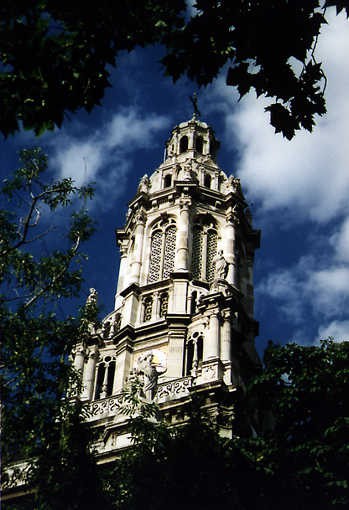The decision to build the Trinité church was made in the Assemblée on the 22nd September 1855. The church, built in a neighbourhood turned upside-down by Haussmann's reconstruction of central Paris, was designed by the architect Théodore Ballu and building work lasted from 1861 to 1867. In fact, the clearing of the present-day place d'Estienne-d'Orves, the widening of the roads around that square and the erection of numerous apartment blocks meant that significant levelling work had to be done in the area, and some buildings of great note, such as the St-Lazare barracks and Cardinal Fech's large town mansion on the rue Chausée d'Antin (designed by Ledoux) had to be demolished.
Ballu's largest work, the Trinité church takes its inspiration from French Renaissance architecture whilst at the same time avoids descending into vulgar pastiche. The tall, narrow façade harmonises well with the surroundings thanks to the small garden which spreads out below the façade and to which the façade is connected by a balustrade terminated by two curved flights of steps. Discover more about parks and gardens provided for Paris by the Second Empire. Take a wander around our itinerary “Parks and Gardens: Parisian strolls of the Second Empire“.
The façade, with its three porches and gallery above, is itself crowned by a large rose window and two large paired windows. This ensemble is then dominated by a four-storey bell tower – square at its base and octagonal above – with two superimposed cupolas at the top.
The decorative programme is highly ambitious. The niches in the porches house statues by Eugène Guillaume whilst the sculpture groups ornamenting the balustrade on the first storey are the work of Jacques Mallet, Pierre Cavelier, J.B. Carpeaux (La Tempérance) and Adolphe Crauck – all these works were replaced with copies during the second world war. In the interior, the holy water stoops were sculpted by Charles Gumery, and there is also a fine Virgin and Child by Paul Dubois. The internal painted decoration was executed many different hands, notably: Emile Levy, Elie Delaunay and Félix Barrias in the choir and Pierre Brisset, J.A. Lecomte de Nouy, Désiré Lauguée, Eugène Thirion, Romain Cazes, Michel Dumas and Louis Français in the side chapels. A huge arch decorated by Félix Jobbé-Duval soars above the organ loft. It was at Trinité that Olivier Messaien was organist for more than forty years.
Trinité Church


